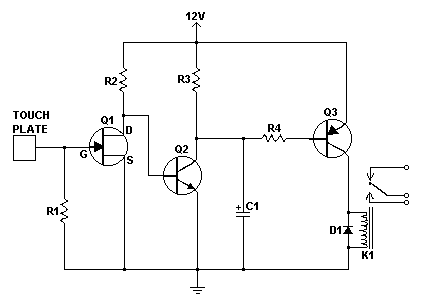Similar to the CMOS based
Touch Switch also on this site, this transistor based touch switch can activate a load simply by the user touching a metal plate. It is designed to directly switch a relay to allow it to be used with large loads. As it uses only a few commonly available transistors and a 12V supply, it is ideal for hostile environments where mechanical switches would be damaged. Using a latching relay and two of these circuits, a simple two pad "touch on/touch off" arrangement can be made.
| Part | Total Qty. | Description | Substitutions | | R1 | 1 | 10 Meg 1/4W Resistor | | | R2 | 1 | 47K 1/4W Resistor | | | R3 | 1 | 120k 1/4W Resistor | | | R4 | 1 | 470 Ohm 1/4W Resistor | | | C1 | 1 | 15uF Electrolytic Capacitor | | | D1 | 1 | 1N4007 Silicon Rectifier Diode | | | Q1 | 1 | 2N5458 N Channel Field Effect Transistor | | | Q2 | 1 | 2N2222 NPN Transistor | 2N3904 | | Q3 | 1 | 2N3906 PNP Transistor | | | K1 | 1 | Relay w/12V Coil, Contacts To Suit Application | | | MISC | 1 | Board, Wire, Small Metal Pad For Touch Pad | |
| |
- The touch pad can be most easily made by cutting a small square of PCB material and then soldering on a single wire. Alternatively, something like a penny glued to a plastic backing will do the job.
- As mentioned, a latching relay can be used so that a momentary touch activates the relay and it remains active. To turn off a latching relay, power must be interrupted. So a 2nd circuit with a normal relay can be used to cut power (use the NC contacts on the 2nd circuit). Placed side by side, two touch pads form an "on" and an "off" pad.






